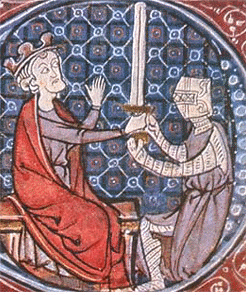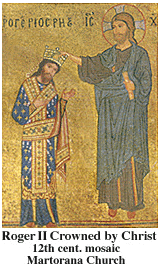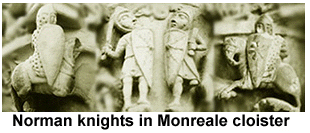...Best of Sicily presents... Best of Sicily Magazine. ... Dedicated to Sicilian art, culture, history, people, places and all things Sicilian. |
by Alberto Lanza | |||
Magazine Index Best of Sicily Arts & Culture Fashion Food & Wine History & Society About Us Travel Faqs Contact Map of Sicily
|
While fundamental Sicilian institutions shared much with their Norman counterparts in England, they were coloured by unique factors, particularly concepts inherited from the Arabs and Byzantines. During the period in question (the Norman and Swabian era from 1061 to 1266) the Kingdom of Sicily included not only the island but most of the Italian peninsula s outh of Rome, ruled from the capital, Palermo. Monarchy Kingship When a monarchy already exists (this obviously was not the case in 1130
when Roger was crowned), succession is actually automatic if an heir apparent
has been designated and is living. Hence the phrase: "The king is dead,
long live the king!" A coronation is a religious rite which confirms
the ascendant monarch's right , authority and ability to rule. This usually presumes
the material power to reign (over an actual defensible territory), approval
by the Church at the time of coronation (hence the bishop's role), and consent
of the people (the nobility).
To avoid possible contestations, the Norman kings of Sicily and England
sometimes nominated their eldest sons successors Sicilian royal authority was thought to emanate from God Himself (reflected in the mosaic shown here of Roger receiving the Crown directly from Christ), and this influenced government and ecclesiastical policy in Sicily until the death of the oft-excommunicated Frederick II in 1250. While it is true that battles, such as that of Hastings in 1066, were often fought between the armies of reigning monarchs, the idea of a king single-handedly duelling a challenger to retain his kingdom owes more to legend than to history. Moreover, true chivalry usually existed more in theory than in fact, at least outside the military-religious orders. The duel planned between Peter of Aragon and Charles of Anjou at Bordeaux in 1283 (under the auspices of King Edward of England) for the Sicilian Crown never took place, and by 1150 the Normans were already setting aside the idea, inherited from their Viking forebears, of "trial by battle," duels between knights to establish guilt or innocence of crimes. Until the arrival of the Normans, the emirs of Bal'harm (Palermo), Kasr'Janni (Enna) and other cities exercised what may have seemed like sovereign authority. In fact, the "Khalbids" (who succeeded the Aghlabids) were at least nominally part of the larger Fatimid Empire. An emir's role was more akin to that of a powerful feudal lord than a king, and Muslim religious authorities monitored the emirs' actions to prevent abuses of power and ensure conformity to Islamic law. Arab society imposed a certain class structure, but nothing so rigid as the feudal system. Barons and Enfeoffed Knights By the time of the Vespers uprising (1282) the feudal system was universal in Sicily, but well into Frederick's reign there were still Arab and Byzantine land holdings administered under the prior systems. It is true that there were serfs (peasants tied to the land) and even a few slaves (held by Arabs) during the Norman era, but in Sicily serfdom was never as commonplace as it was in the German lands, France, England and Russia. That doesn't mean that by 1250 a poor peasant farmer could simply decide to leave the hinterland for the city, as he might have debts and obligations to the lord on whose land he lived, but it does mean that he was not formally the property of that same lord. In demesnial cities and towns appertaining directly to the Crown (Castrogiovanni, Calascibetta, Messina, Catania, Siracusa, Piazza Armerina, Trapani, etc.), as opposed to feudal cities, there were no feudal lords, and in many districts the feudal authority was the abbot of a monastery - though these clerics were not always any more charitable or humane to peasants than were the arrogant barons. The numerous Arab-founded towns and hamlets were only gradually incorporated into the feudal system as the Muslims converted to Christianity. The earliest barons were actually enfeoffed knights who held their tenure to the fief at the will and pleasure of the king, to whom they rendered military service (typically 40 days per year) for this privilege. They didn't have a "freehold" ownership of the land, and were succeeded by heirs (sons) only with royal approval. By 1282 the military obligations still existed but most feudal lands had become, in effect, the personal property of the barons. It is interesting that at this date inheritance was still influenced by a family's ancestral traditions: the Lombard families followed the self-destructive Longobard system of dividing a fief among sons, while the Norman and Angevin families enforced transmission of the entire fief to the eldest son according to the Frankish practice. Some Norman barons initially resisted King Roger's royal authority because of rivalry within his Hauteville family (with certain barons supporting Roger's cousins or other Norman claimants to territories on mainland Italy), or because of resentment that the grandson of a mere knight would claim kingship. However, this phenomenon was not restricted to Sicily; the rebellion of Symon de Montfort against King Henry III of England in 1264 comes to mind. The procedure for assuming a fief formally is called feudal investiture (sometimes undertaken during a "commendation ceremony"), though it differs from the chivalric investiture of knights (below). The hierarchy of titles of nobility beyond baron (viscount, count, marquis, duke, noble prince) came into wide use in southern Italy after the period under consideration here. Nobility was hereditary along legitimate lines, but only a king could ennoble a common man. In general parlance, the terms seigneur, vassallo and chevalier were most common in Sicily until the end of the thirteenth century, on occasions when titles of this kind were even used. Use of the title "baron" came later. In fact, a toponym was often sufficient to identify a member of the nobility. (This is explained under 'surnames' below.) Knights and Esquires
Chivalric investiture was a dubbing ceremony following an all-night vigil spent at prayer in a chapel. We associate dubbing with the tap of a sword blade on each shoulder but the earlier version was the slapping of the kneeling esquire's cheek with a leather gauntlet. The sons of the king might be knighted at sixteen or eighteen, and this marked their coming-of-age as well as their earliest stage of military training. Ordinary esquires might be knighted around the age of twenty. While feudal investiture (bestowing a fief upon a lord) was not necessarily a religious ceremony, chivalric investiture (bestowing the state of knighthood upon a squire ad personam) usually was a rite performed in a church or chapel. It should be mentioned that chivalric investiture became a religious ceremony after 1100; the earliest Norman knights present in Sicily were dubbed in very simple ceremonies. A knight was more than a fighting horseman, and feudal knights were usually invested by the king or his designated representative (a member of the royal family, a bishop or a noble), but certain nobles, and even senior feudal knights, could also dub knights on their own authority. In the military-religious orders the duty of investing knights was the prerogative of the order's leader, the grand master, though some of the men serving in these orders would have already been dubbed by their own kings before enlisting. By 1200 the Hospitallers, Templars and Teutonic Knights all had commanderies in Sicily. The code of chivalry, to the extent that it ever reflected more than an ideal, was probably more evident in the military-religious orders than among the feudal knights. At its best, and when extended from theory into practice, it embodied honourable behaviour of the knight: fealty to his sovereign, respect for women, children and clergy, honour in combat, honesty. In principle at least, it epitomised all the virtues. Sadly, it was rarely applied, and then it usually had classist overtures, with knights treating members of their own social class chivalrously while showing little respect for peasants. Knights were not the only men-at-arms. There were also footmen (infantry), archers and such, many of whom normally performed civilian roles during times of peace. On short notice the Sicilian kings could count on raising a mounted army of as many as 800 knights from around the island (in addition to those from the mainland). Certain Italian dynastic orders of knighthood still exist, though today's knights can hardly be compared to the warriors of old. Surnames Bishops, Priests, Monks Heraldry Many explanations have been suggested for the use of these insignia on shields for identification during combat or at tournaments. They supposedly identified the helmeted, armoured knight to friend and foe, but why was no such need determined centuries earlier? The tournament theory seems the more likely. "Canting arms" were popular in Sicily. This meant that the symbols on the shield were literally allusive to the knight's surname - a lion for Leone, an ox for Bue, an olive tree for Oliviero, a red field for Rosso, a tower for La Torre, a horseshoe for Maniscalco, a fountain for Fontana, a mountain for Montagna, a sword for Spada, and so forth. The keeping of heraldic records was the job of court officers known as heralds. (Our heraldry page links to articles on related topics.) Suggested Reading: The Sicilian Nobility on Best of Sicily The Middle Ages. Morris Bishop The Normans in Sicily: The Normans in the South 1016-1130 and the Kingdom in the Sun 1130-1194. John Julius Norwich The Norman Kingdom of Sicily. Donald Matthew Roger II of Sicily: A Ruler between East and West. Hubert Houben. Frederick II: A Medieval Emperor. David Abulafia The Sicilian Vespers: A History of the Mediterranean World in the Later Thirteenth Century. Steven Runciman The Monks of War. Desmond Seward. About the Author: Alberto Lanza has written various articles on Italian heraldry and related topics. He resides in Catania and conducts historical and genealogical research in eastern Sicily. | ||
Top of Page |
 King, Queen,
Count, Baron, Knight, Esquire. Certain words are more familiar to us for
their literary connotations than for their actual meanings. Owing largely
to impressions from literature and cinema, entire historical periods and
institutions are understood, or perceived, from just a few key elements,
while important facts relating to the terms are conveniently ignored. But
historical context should never be overlooked. With this in mind, let's
cast a glance over some features of medieval Sicily's royal and feudal institutions,
specifically kingship, nobility and knighthood. This is intended only as
a brief overview to consider how these institutions existed in Sicily, and
to dispel misconceptions. For those who visit Sicily, it may be helpful
in better understanding those many details not mentioned by travel books
or tour guides. In the interest of brevity we'll stick to generalities and
the frequent simplification. Books on these topics are listed at the end
of the article.
King, Queen,
Count, Baron, Knight, Esquire. Certain words are more familiar to us for
their literary connotations than for their actual meanings. Owing largely
to impressions from literature and cinema, entire historical periods and
institutions are understood, or perceived, from just a few key elements,
while important facts relating to the terms are conveniently ignored. But
historical context should never be overlooked. With this in mind, let's
cast a glance over some features of medieval Sicily's royal and feudal institutions,
specifically kingship, nobility and knighthood. This is intended only as
a brief overview to consider how these institutions existed in Sicily, and
to dispel misconceptions. For those who visit Sicily, it may be helpful
in better understanding those many details not mentioned by travel books
or tour guides. In the interest of brevity we'll stick to generalities and
the frequent simplification. Books on these topics are listed at the end
of the article. during their
own lifetimes, and coronations were held to confirm these choices. William, son of King Roger of Sicily was crowned
in 1151. Henry, eldest son of King Henry II of England, was crowned as "rex filius" in 1170, though he
pre-deceased his father and thus never actually ascended the throne (which went to his brother, Richard I "Lionheart").
Medieval kings were occasionally deposed; in the 1260s Charles of Anjou deposed the young heirs of Frederick II
(through victorious battles in mainland Italy) to become king of Sicily, only to lose the island to Peter of Aragon through the
Sicilian Vespers uprising in 1282, though Charles was able to retain the peninsular territories, which
he continued to rule from Naples.
during their
own lifetimes, and coronations were held to confirm these choices. William, son of King Roger of Sicily was crowned
in 1151. Henry, eldest son of King Henry II of England, was crowned as "rex filius" in 1170, though he
pre-deceased his father and thus never actually ascended the throne (which went to his brother, Richard I "Lionheart").
Medieval kings were occasionally deposed; in the 1260s Charles of Anjou deposed the young heirs of Frederick II
(through victorious battles in mainland Italy) to become king of Sicily, only to lose the island to Peter of Aragon through the
Sicilian Vespers uprising in 1282, though Charles was able to retain the peninsular territories, which
he continued to rule from Naples. Whichever destiny awaited him, a postulant to knighthood would acquire
his military training as the esquire of a knight, perhaps living
for a few years at the castle of a neighbouring lord or performing service
at court. Knights were usually drawn from the landholding class, though
there in practice were actually many exceptions to this rule.
Whichever destiny awaited him, a postulant to knighthood would acquire
his military training as the esquire of a knight, perhaps living
for a few years at the castle of a neighbouring lord or performing service
at court. Knights were usually drawn from the landholding class, though
there in practice were actually many exceptions to this rule.